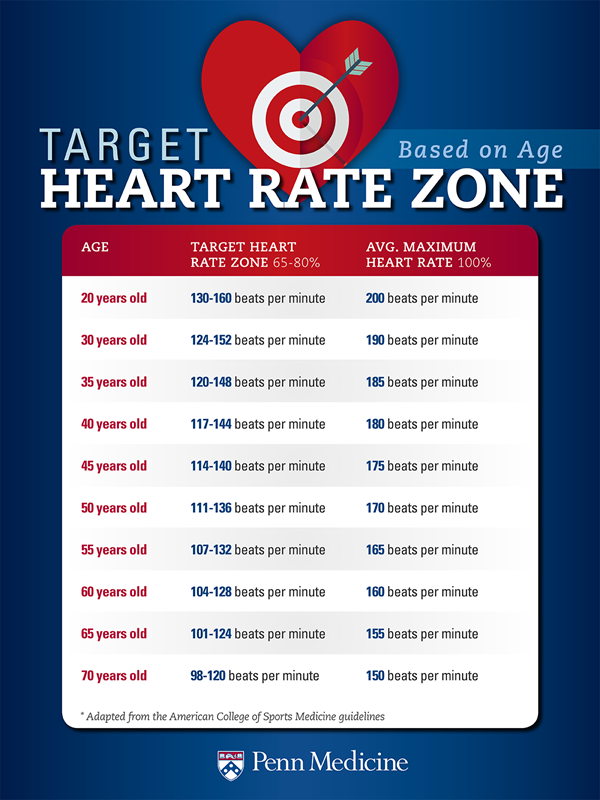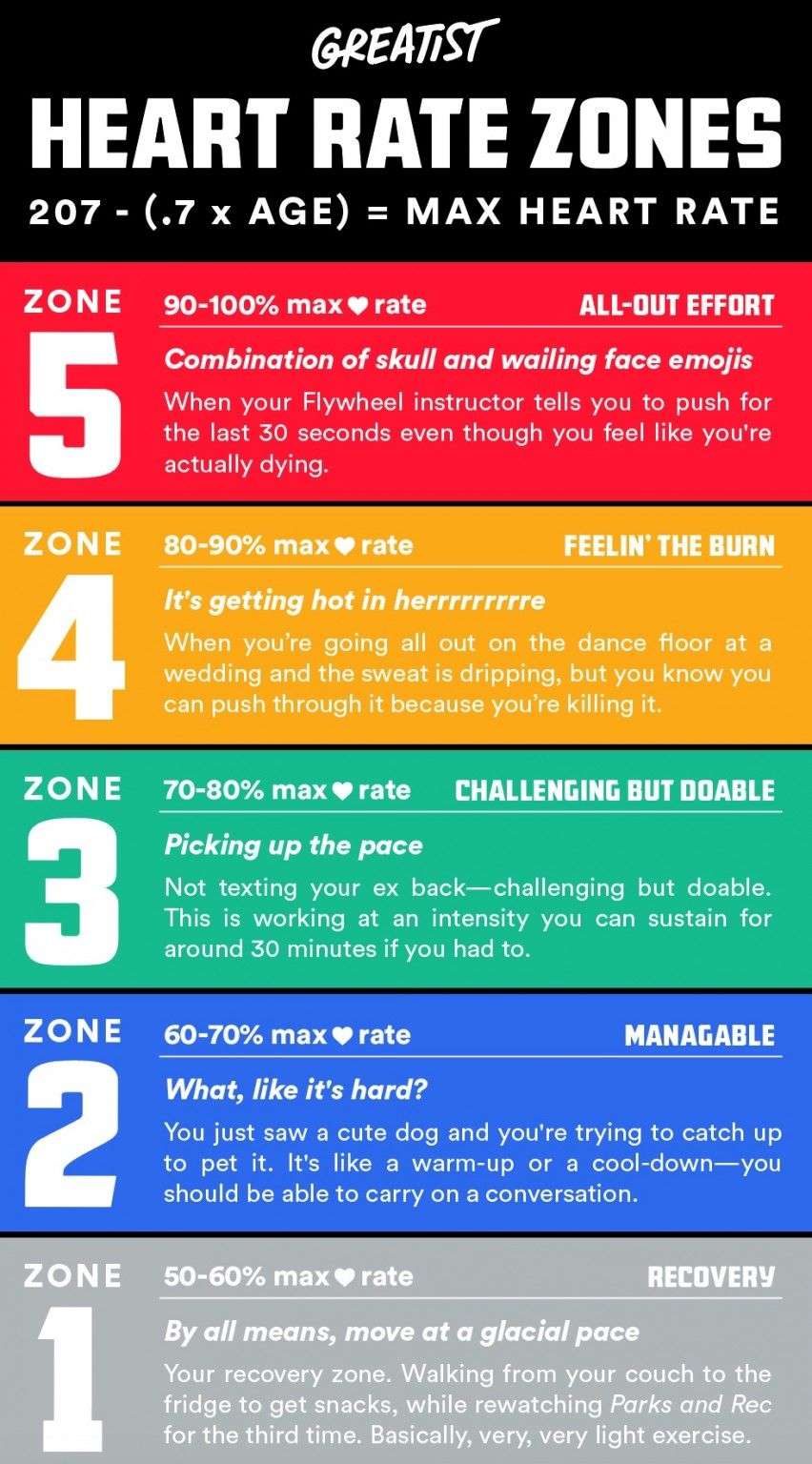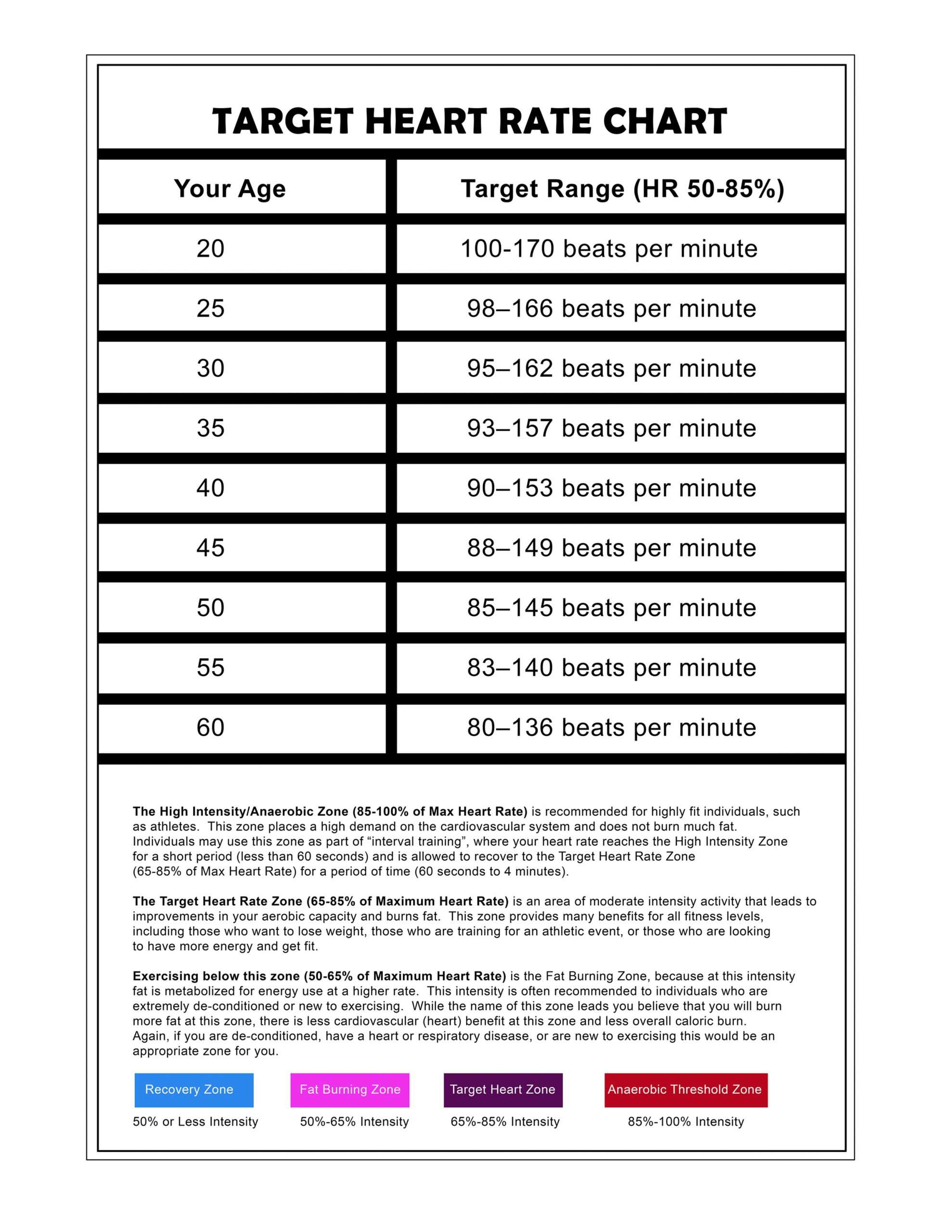Calculating Target Heart Rate
For many years, health professionals recommended that men and women subtract their age from 220 to get an approximation of their maximum heart rate. Using this formula, you multiply maximum heart rate by your desired workout heart rate intensity to get your target heart rate. For example, if you are 30 years old, subtract 30 from 220 to get 190, then multiply it by .70 and .80 if you want to exercise in the common aerobic heart rate range. This 220-minus-age formula is too high for women, however, according to Northwestern Medicine researchers who studied more than 5,000 women in 2010. They found that women should multiply their age by .88, then subtract this number from 206 to get a more accurate maximum heart rate. A 30-year-old woman who wanted to exercise at 70 to 80 percent of her target heart rate would work out between 126 and 144 beats per minute using this formula. Using the old 220-minus-age formula, she would have to exercise between 133 and 152 beats per minute.
References
How To Get In The Aerobic Zone
Aerobic exercise gets your lungs and heart pumping to deliver the oxygen to your muscle cells, which use it to pro-duce energy. You can use your heart rate to find the level of exercise that gets you in the aerobic zone and enhance cardiovascular fitness. Subtract your age from 220 to roughly approximate your maximum heart rate during exercise. Exercising at between 60% and 70% of your estimated maximum heart rate is sufficient to build cardiovascular fitness. If you can gradually condition your way up to 80%, the fitness gains will be even more noticeable. Using a wearable heart rate monitor can help you stay in the aerobic zone and show the benefits as your fitness improves.
What Percentage Of Your Workout Should Be In Your Target Heart Rate
If you’re new to exercise — or you’re just trying to get more strategic about your workouts — you may have heard a lot about target heart rates and their importance for getting in a beneficial workout. You may even have heard people talk about breaking their workouts into a specific percentage of time spent at a certain rate. That might all seem confusing or downright daunting, but the truth is, 100 percent of your workout should be spent in the target zone.
Also Check: Tylenol For High Blood Pressure
How To Measure Your Target Heart Rate
You can take your heart rate manually: Find your pulse on the inside of your wrist or your neck using the tips of your first two fingers on the opposite hand. Count the beats for 30 seconds and multiply by two to find your beats per minute.
Of course, technology can help, too. Wearable activity tracker devices such as a Fitbit or Apple Watch have gained in popularity in the past decade and can help you monitor your heart rate during exercise and rest.
Easy Steps To Find Your Target Heart Rate Range

Ryan Lawson, Exercise Specialist
Were all familiar with the phrase use it or lose it, and it perfectly applies to our body and muscles. Muscles are made to be used, and if theyre neglected its our health and quality of life that suffers.
Cardiovascular exercise is defined as any activity that increases your heart rate. Elevating your heart rate for an extended period of time will improve your heart health. A stronger, healthier heart is able to more efficiently deliver oxygen to the muscles and also burn more fat while youre exercising and resting.
The benefits of a stronger heart through cardiovascular exercise are numerous. In addition to a stronger heart and lungs, regular exercise has been shown to lead to better sleep, less stress, reduction in mood swings and depression and an overall more active lifestyle.
You have a target heart rate zone that you should strive for during activity. A simple way to calculate it would be to first find your predicted maximum heart rate, which you can find by subtracting your age from 220. Once youve figured your maximum heart rate, you can find your target healthy heart rate range by multiplying your maximum heart rate by 65 percent to find the low end of that range and multiply your maximum heart rate by 85 percent to find the high end of the range.
Example: The maximum heart rate for a 45-year-old is 175 and the target heart rate range would be about 113 to 149 beats per minute.
Recommended Reading: Tylenol Heart Palpitations
Target Heart Rate Calculator
Ever ask yourself, “how do I find my target heart rate?” Finding your target heart rate is easy with our target heart rate calculator. Target heart rate calculation can be determined for any age and activity level, enabling you to use a heart rate monitor and get the most benefit from your workouts.
Target Heart Rate And Estimated Maximum Heart Rate
One way of checking physical activity intensity is to determine whether your pulse or heart rate is within the target zone during physical activity.1
For moderate-intensity physical activity, your target heart rate should be between 64% and 76%1,2 of your maximum heart rate. You can estimate your maximum heart rate based on your age. To estimate your maximum age-related heart rate, subtract your age from 220. For example, for a 50-year-old person, the estimated maximum age-related heart rate would be calculated as 220 50 years = 170 beats per minute . The 64% and 76% levels would be:
- 64% level: 170 x 0.64 = 109 bpm, and
- 76% level: 170 x 0.76 = 129 bpm
This shows that moderate-intensity physical activity for a 50-year-old person will require that the heart rate remains between 109 and 129 bpm during physical activity.
For vigorous-intensity physical activity, your target heart rate should be between 77% and 93%1,2 of your maximum heart rate. To figure out this range, follow the same formula used above, except change 64 and 76% to 77 and 93%. For example, for a 35-year-old person, the estimated maximum age-related heart rate would be calculated as 220 35 years = 185 beats per minute . The 77% and 93% levels would be:
- 77% level: 185 x 0.77 = 142 bpm, and
- 93% level: 185 x 0.93 = 172 bpm
Recommended Reading: Tylenol Lower Heart Rate
Whats A Normal Heart Rate By Age
One of the key factors that influence our heart rate is age. Like so many parts of our body, your hearts capacity and functionality changes over the course of your life. So your age is a useful metric for estimating your maximum heart rate .
By discovering your MHR, you can then work out your personal heart rate zones. These are useful for helping you to understand how different types of exercise have a specific effect on your heart and overall fitness.
You can use these zones to create a heart rate training plan, which is a great way of ensuring that you are doing a variety of exercises. By regularly exercising in different heart rate zones, you will get the most out of what you put in.
Target Heart Rate For Weight Loss: Make Workouts Work For You
Learning how to calculate your target heart rate zone is an important piece of the weight loss puzzle. Your target heart rate zone, comprised of an upper and lower heart rate, makes both high-intensity and low-intensity workouts more efficient no matter how long they last.
In addition to burning more fat and calories, exercising in your target heart rate zone provides insight into how your body works and what it needs for optimal results. Whether youre looking to slim down or bulk up, heres how to apply your target heart rate for weight loss.
Recommended Reading: Fluticasone Heart Palpitations
Measure Your Heart Rate
To determine your heart rate, use your first two fingers to press lightly over the blood vessels on your inner wristthe side by your thumb. Count your pulse for ten seconds and multiply this number by six.
If your heart rate is 50 to 85 percent of your maximum heart rate, you have hit your target heart zone and are working at the right level of intensity.
Wearing a multifunctional fitness tracker such as the Fitbit, or Nike+ FuelBand SE, does the work for you. The device is worn like a bracelet or watch and measures your heart rate.
Exercising at the right level of intensity improves heart and respiratory endurance and helps keep your workout at a level that is vigorous enough to meet your health goals.
Moderate: 64% To 76% Of Mhr
The moderate heart rate zone is from 64% to 76% of your maximum heart rate. This is the higher end of the moderate-intensity exercise zone. If using the talk test to measure your intensity, you will be breathing heavier but will still be able to speak in short sentences.
You burn more calories per minute than in the light heart zone because the exercise is a little more intense.
In the moderate heart rate zone, your body fuels itself with 10% carbohydrates, 5% protein, and 85% fat.
You get the same health benefits and fat-burning benefits as the light heart zone. An example of a workout in this zone is a brisk walking workout.
Don’t Miss: Coronary Insufficiency Symptoms
Anaerobic Heart Rate Zones
Anaerobic exercise requires even more intense effort than aerobic exercise. Exercising at 80%-90% of your maximum heart rate for a short period of time is considered anaerobic. One of the best ways to engage in anaerobic exercise is through interval training or high intensity interval training, also known as HIIT.
How Long Should You Stay At Your Maximum Heart Rate

Heart is the main organ which is responsible for the circulation of the blood throughout the body. With every heartbeat, the heart pumps oxygenated blood and other nutrients to different parts of the body. It is on the supply of this oxygenated blood that the brain and other organs function in a proper manner. In the absence of this oxygenated blood, it could lead to a slow and painful death. The heart rate is calculated by counting the number of beats in a minute. Depending upon the condition of your health and the kind of activities that you have indulged into at a certain time, the heart rate is affected. The average normal heart rate is 72 beats per minute when one is not physically exerting. It is said that your heart rate is a direct indication of the overall condition of your health. There is a certain limit within which this heartbeat rate must be restricted to, surpassing which could actually lead to a cardiac problem.
Recommended Reading: Tylenol And High Blood Pressure
Heart Rate Zone : 90100% Of Hrmax
Heart rate zone 5 is your maximal effort. Your heart and your blood and respiratory system will be working at their maximal capacity. Lactic acid will build up in your blood and after a few minutes you wont be able to continue at this intensity.
If youre just starting out or have only been training for some time, you probably wont have to train at this intensity. If youre a professional athlete, look into incorporating interval training into your training plan for peak performance.
How To Monitor Heart Rate During Exercise
There are two different ways of measuring and monitoring your heart rate during exercise.
Both options are very precise, so it simply comes down to which device you prefer for the way you exercise.
If you liked this post, dont forget to share so that others can find it, too.
Also Check: Gerd Rapid Heart Beat
Is It Ok To Go Over Your Target Heart Rate
It is possible to exceed the upper limit of your zone without any ill effects, as long as you do not have coronary artery disease or are at risk for a heart attack. What it may do, though, is leave you with a musculoskeletal injury. Exercising above 85% of your target heart rate could bring you sore joints and muscles.
Why You Should Monitor Your Exercise Heart Rate
- Your target heart rate is a guideline that can help you stay in a safe exercise heart rate range.
- An average resting heart rate is between 60 to 100 beats each minute.
- Because medication may affect your heart rate, its important to check with your health care provider before starting an exercise routine.
The benefits of regular workouts and exercise are huge.Regular aerobic exercise helps your cardiovascular system become more efficient, transporting oxygen and nutrients to your tissues and working muscles.The more effective your body is at doing this, the more energy you feel, the better your immune system functions, and your risk factors for many diseases are greatly reduced. Exercise also releases endorphins which help reduce stress and improve your emotional and mental health.
Even a little exercise is better than none at all. The American College of Sports Medicine recommends at least 30 minutes of physical activity five days a week. If you cant find the time for a full half hour workout, three, 10-minute sessions may have similar health benefits, as long as you increase your heart rate to a level that gives your heart a good workout.
Read Also: Dehydration And Arrhythmia
What Causes An Increase In Heart Rate And What Is The Maximum Heart Rate
When your body is doing a certain physical activity such as walking, a workout or an exercise session, it means that your muscles, tissues and other parts of the body are in a larger requirement of oxygenated blood. In order to fulfill this requirement, your heart has to pump faster and larger portions of blood to the various parts of your body.
This increases the heartbeat to various levels. The ideal heartbeat rate which it should be at its maximum level will differ from person to person. The two factors of weight and age happen to play a very important role in this context. It is said that the ideal limit of your maximum heart rate is your age subtracted from the number 220. So, if your age is 30, then the maximum heart rate that you can attain is 220-30 = 190. It is obvious that the maximum heart rate is something that will differ from person to person, depending on their age.
Determine Maximum Heart Rate
Once you learn your maximum heart rate , you can use heart zone training to gear your workout to the correct intensity. Your maximum heart rate is as fast as your heart can beat. This varies for each person, but age is generally used as a guide to estimate what your maximum heart rate is likely to be.
One of the easiest ways to determine your MHR is to subtract your age from 220. For instance, if you are 40 years old, your MHR is 180 .
You can also use the Tanaka formula, which is multiplying your age by 0.7, then subtracting that number from 208. So, for a 40-year-old, this calculation would also give an MHR of 180 = 180).
A more individualized number can be provided through testing by a personal trainer or as a function of some of the more expensive heart rate monitors. You can also use an age-based heart rate chart to find your target heart rates based on percentages of your max.
Recommended Reading: Acetaminophen Heart Rate
Your Target Heart Rate
Because hanging out in the max zone for too long can be dangerous, you need to find a range that’s both safe and intense enough to give you a good workout that’s where your target heart rate zone comes in.
According to the AHA, your target heart rate zone during moderate-intensity exercise is about 50 to 70 percent of your max heart rate. If you want to work at a vigorous level, you bump the range up to 70 to 85 percent of maximum.
Additionally, you can skip the math session and use one of the online calculators to do the calculation for you. The American Council on Exercise has one that calculates your target heart rate range based on whether you’re at a beginner, intermediate or advanced fitness level.
The bottom line: It’s always important to consult a doctor before starting any new exercise program, especially if it’s strenuous. In some cases, a visit to the doctor is especially important before engaging in activities that will raise your heart rate to the top of the recommended cardiovascular zone for your age.
What Are The Benefits

Interval training allows you to accomplish the same amount of exercise “work” in less time. That could make workouts easier to fit into a busy day or open a time slot to add some strength training. If you can reduce your moderate 30-minute workout to 15 or 20 minutes of interval training, the cardiovascular benefit should be about the same.
As fitness improves, you should feel better, with greater endurance and more get-up-and-go. However, cardiovascular training doesn’t significantly boost muscle strength or power. Knuttgen points out that even elite marathoners don’t have unusually strong leg muscles. But their hearts and lungs work together at peak performance.
No matter what type of cardiovascular training you choose, you need to do it regularly to see the improvements. “Three days a week is a good recommendationmore if you can, but not much less and definitely not just once a week,” Knuttgen says.
You May Like: Drugs That Stop The Heart
